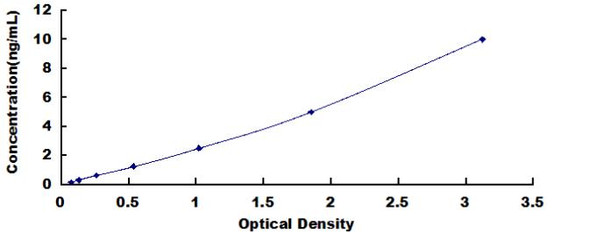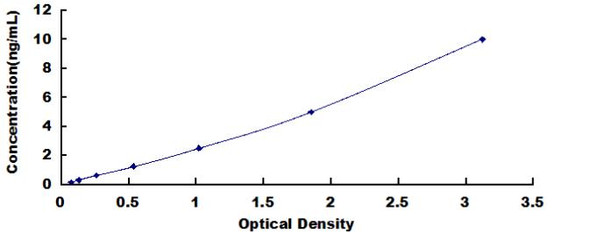Human DNMT1 ELISA Kit (HUFI01767)
- SKU:
- HUFI01767
- Product Type:
- ELISA Kit
- Size:
- 96 Assays
- Uniprot:
- P26358
- Sensitivity:
- 0.094ng/ml
- Range:
- 0.156-10ng/ml
- ELISA Type:
- Sandwich
- Synonyms:
- DNMT1, DNA, cytosine-5-methyltransferase 1, CXXC9, MCMT, AIM, CXXC9CXXC finger protein 9, CXXC-type zinc finger protein 9, DNA, cytosine-5--methyltransferase 1, DNA, cytosine-5-methyltransferase 1, DNA methyltransferase 1, DNA methyltransferase HsaI,
- Reactivity:
- Human
- Research Area:
- Epigenetics and Nuclear Signaling
Description
Human DNMT1 ELISA
DNMT1 (DNA Methyltransferase 1) encoded protein is a methyltransferase that specifically methylates DNA cytosines in CpG dinucleotides. This methylation is required for normal development and function of the immune system. Mutations in DNMT1 are associated with immunodeficiency and developmental delays. Diseases associated with DNMT1 include Cerebellar Ataxia, Deafness, And Narcolepsy, Autosomal Dominant and Neuropathy, Hereditary Sensory, Type Ie. Among DNMT1 related pathways are Trans-sulfuration pathway and Trans-sulfuration and one carbon metabolism.
Key Features
| Save Time | Pre-coated 96 well plate | |
| Quick Start | Kit includes all necessary reagents | |
| Publication Ready | Reproducible and reliable results |
Overview
| Product Name: | Human DNMT1 ELISA Kit |
| Product Code: | HUFI01767 |
| Size: | 96 Assays |
| Alias: | DNMT1, DNA, cytosine-5-methyltransferase 1, CXXC9, MCMT, AIM, CXXC9CXXC finger protein 9, CXXC-type zinc finger protein 9, DNA, cytosine-5--methyltransferase 1, DNA, cytosine-5-methyltransferase 1, DNA methyltransferase 1, DNA methyltransferase HsaI, DNA MTase HsaI, DNMT |
| Detection Method: | Sandwich ELISA, Double Antibody |
| Application: | This immunoassay kit allows for the in vitro quantitative determination of Human DNMT1 concentrations in serum plasma and other biological fluids. |
| Sensitivity: | 0.094ng/ml |
| Range: | 0.156-10ng/ml |
| Storage: | 4°C for 6 months |
| Note: | For Research Use Only |
Additional Information
| Recovery: | Matrices listed below were spiked with certain level of Human DNMT1 and the recovery rates were calculated by comparing the measured value to the expected amount of Human DNMT1 in samples.
| ||||||||||||||||||||
| Linearity: | The linearity of the kit was assayed by testing samples spiked with appropriate concentration of Human DNMT1 and their serial dilutions. The results were demonstrated by the percentage of calculated concentration to the expected.
| ||||||||||||||||||||
| CV(%): | Intra-Assay: CV<8% |
Kit Components
| Component | Quantity | Storage |
| ELISA Microplate (Dismountable) | 8x12 strips | 4°C for 6 months |
| Lyophilized Standard | 2 | 4°C/ -20°C |
| Sample/Standard Dlution Buffer | 20ml | 4°C |
| Biotin-labeled Antibody (Concentrated) | 120ul | 4°C (Protection from light) |
| Antibody Dilution Buffer | 10ml | 4°C |
| HRP-Streptavidin Conjugate (SABC) | 120ul | 4°C (Protect from light) |
| SABC Dilution Buffer | 10ml | 4°C |
| TMB Substrate | 10ml | 4°C (Protection from light) |
| Stop Solution | 10ml | 4°C |
| Wash Buffer (25X) | 30ml | 4°C |
| Plate Sealer | 5 | - |
Other materials required:
- Microplate reader with 450 nm wavelength filter
- Multichannel Pipette, Pipette, microcentrifuge tubes and disposable pipette tips
- Incubator
- Deionized or distilled water
- Absorbent paper
- Buffer resevoir
Protein Information
| Uniprot: | |
| UniProt Protein Function: | DNMT1: an ubiquitous DNA methyltransferase that methylates CpG residues. Preferentially methylates hemimethylated DNA. It is responsible for maintaining methylation patterns established in development, and may play an active role in DNA damage repair. Mediates transcriptional repression by direct binding to HDAC2. Its abundance is reduced to non detectable levels at the G0 phase of the cell cycle and is dramatically induced upon entrance into the S-phase of the cell cycle. Interacts with HDAC1 and with PCNA. Forms a complex with DMAP1 and HDAC2, with direct interaction. Forms also a stable complex with E2F1, BB1 and HDAC1. Binds MBD2 and MBD3. Three isoforms of the human protein produced by alternative splicing have been described. |
| UniProt Code: | |
| NCBI GenInfo Identifier: | |
| NCBI Gene ID: | |
| NCBI Accession: | |
| UniProt Related Accession: |
Protocol
*Note: Protocols are specific to each batch/lot. For the exact instructions please follow the protocol included in your kit.
Before adding to wells, equilibrate the SABC working solution and TMB substrate for at least 30 min at 37°C. When diluting samples and reagents, they must be mixed completely and evenly. It is recommended to plot a standard curve for each test.
| Step | Procedure |
| 1. | Set standard, test sample and control (zero) wells on the pre-coated plate respectively, and then, record their positions. It is recommended to measure each standard and sample in duplicate. Wash plate 2 times before adding standard, sample and control (zero) wells! |
| 2. | Aliquot 0.1ml standard solutions into the standard wells. |
| 3. | Add 0.1 ml of Sample / Standard dilution buffer into the control (zero) well. |
| 4. | Add 0.1 ml of properly diluted sample ( Human serum, plasma, tissue homogenates and other biological fluids.) into test sample wells. |
| 5. | Seal the plate with a cover and incubate at 37 °C for 90 min. |
| 6. | Remove the cover and discard the plate content, clap the plate on the absorbent filter papers or other absorbent material. Do NOT let the wells completely dry at any time. Wash plate X2. |
| 7. | Add 0.1 ml of Biotin- detection antibody working solution into the above wells (standard, test sample & zero wells). Add the solution at the bottom of each well without touching the side wall. |
| 8. | Seal the plate with a cover and incubate at 37°C for 60 min. |
| 9. | Remove the cover, and wash plate 3 times with Wash buffer. Let wash buffer rest in wells for 1 min between each wash. |
| 10. | Add 0.1 ml of SABC working solution into each well, cover the plate and incubate at 37°C for 30 min. |
| 11. | Remove the cover and wash plate 5 times with Wash buffer, and each time let the wash buffer stay in the wells for 1-2 min. |
| 12. | Add 90 µl of TMB substrate into each well, cover the plate and incubate at 37°C in dark within 10-20 min. (Note: This incubation time is for reference use only, the optimal time should be determined by end user.) And the shades of blue can be seen in the first 3-4 wells (with most concentrated standard solutions), the other wells show no obvious color. |
| 13. | Add 50 µl of Stop solution into each well and mix thoroughly. The color changes into yellow immediately. |
| 14. | Read the O.D. absorbance at 450 nm in a microplate reader immediately after adding the stop solution. |
Sample Type
When carrying out an ELISA assay it is important to prepare your samples in order to achieve the best possible results. Below we have a list of procedures for the preparation of samples for different sample types.
| Sample Type | Protocol |
| Serum | If using serum separator tubes, allow samples to clot for 30 minutes at room temperature. Centrifuge for 10 minutes at 1,000x g. Collect the serum fraction and assay promptly or aliquot and store the samples at -80°C. Avoid multiple freeze-thaw cycles. If serum separator tubes are not being used, allow samples to clot overnight at 2-8°C. Centrifuge for 10 minutes at 1,000x g. Remove serum and assay promptly or aliquot and store the samples at -80°C. Avoid multiple freeze-thaw cycles. |
| Plasma | Collect plasma using EDTA or heparin as an anticoagulant. Centrifuge samples at 4°C for 15 mins at 1000 × g within 30 mins of collection. Collect the plasma fraction and assay promptly or aliquot and store the samples at -80°C. Avoid multiple freeze-thaw cycles. Note: Over haemolysed samples are not suitable for use with this kit. |
| Urine & Cerebrospinal Fluid | Collect the urine (mid-stream) in a sterile container, centrifuge for 20 mins at 2000-3000 rpm. Remove supernatant and assay immediately. If any precipitation is detected, repeat the centrifugation step. A similar protocol can be used for cerebrospinal fluid. |
| Cell culture supernatant | Collect the cell culture media by pipette, followed by centrifugation at 4°C for 20 mins at 1500 rpm. Collect the clear supernatant and assay immediately. |
| Cell lysates | Solubilize cells in lysis buffer and allow to sit on ice for 30 minutes. Centrifuge tubes at 14,000 x g for 5 minutes to remove insoluble material. Aliquot the supernatant into a new tube and discard the remaining whole cell extract. Quantify total protein concentration using a total protein assay. Assay immediately or aliquot and store at ≤ -20 °C. |
| Tissue homogenates | The preparation of tissue homogenates will vary depending upon tissue type. Rinse tissue with 1X PBS to remove excess blood & homogenize in 20ml of 1X PBS (including protease inhibitors) and store overnight at ≤ -20°C. Two freeze-thaw cycles are required to break the cell membranes. To further disrupt the cell membranes you can sonicate the samples. Centrifuge homogenates for 5 mins at 5000xg. Remove the supernatant and assay immediately or aliquot and store at -20°C or -80°C. |
| Tissue lysates | Rinse tissue with PBS, cut into 1-2 mm pieces, and homogenize with a tissue homogenizer in PBS. Add an equal volume of RIPA buffer containing protease inhibitors and lyse tissues at room temperature for 30 minutes with gentle agitation. Centrifuge to remove debris. Quantify total protein concentration using a total protein assay. Assay immediately or aliquot and store at ≤ -20 °C |
| Breast Milk | Collect milk samples and centrifuge at 10,000 x g for 60 min at 4°C. Aliquot the supernatant and assay. For long term use, store samples at -80°C. Minimize freeze/thaw cycles. |
DNMT1 Background
DNMT1, also known as DNA methyltransferase 1, is an essential enzyme involved in the process of DNA methylation, which is an epigenetic modification that regulates gene expression. Epigenetics refers to changes in gene expression that occur without altering the DNA sequence itself. Instead, these changes are often reversible and can be influenced by various factors, such as environmental conditions and lifestyle choices.
DNA Methylation and Epigenetics
DNA methylation involves the addition of a methyl group (-CH3) to the cytosine base of DNA molecules, predominantly occurring at cytosine-guanine dinucleotides, commonly referred to as CpG sites. This methylation process usually leads to the repression of gene expression, although it can also have other regulatory roles depending on the genomic context.
The Role of DNMT1 in DNA Methylation
DNMT1 primarily oversees the maintenance of DNA methylation patterns during cell division and replication. It ensures that the pattern of DNA methylation is copied from the parent strand to the newly synthesized daughter strand during cell division. This function is crucial for the preservation of epigenetic information throughout successive cell generations and plays a fundamental role in cell differentiation and development.
DNMT1 FAQs
What is the DNMT1 ELISA Kit?
The DNMT1 ELISA Kit is an advanced assay designed to accurately quantify Human DNA methyltransferase 1 levels in biological samples.
What are the advantages of using the DNMT1 ELISA Kit?
The DNMT1 ELISA Kit offers high sensitivity, specificity for Human DNMT1, an easy-to-use protocol, quantitative results, compatibility with various samples, and time-efficiency for research screening.
Where can I find more information about the DNMT1 ELISA Kit?
For more detailed information about the DNMT1 ELISA Kit, including technical specifications, performance characteristics, and ordering details, please refer to the product brochure or contact our customer support team. We are here to assist you with any inquiries you may have.






